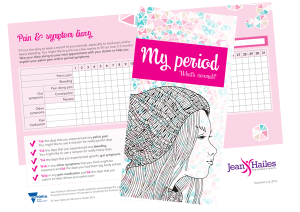
Heavy menstrual bleeding affects one in four women in Australia, having a significant impact on their social, emotional and physical wellbeing.
Unfortunately, many women don't know their bleeding is heavy, let alone that heavy menstrual bleeding isn't normal. Or, they may not know about effective treatment options. As a result, they endure it in silence.
However, in most cases, the condition can be treated effectively without surgery.
General practitioner Dr Louise Sterling, a member of a working group involved in developing a recent industry standard on heavy menstrual bleeding for health professionals, says women do not need to put up with heavy menstrual bleeding, and neither should they think surgery is the only option.
"Invasive surgery is a last resort," Dr Sterling says.
She says in most cases, the bleeding can be treated effectively by a GP, without needing referral to a specialist gynaecologist.
It can be hard to know if the bleeding is abnormal, so the first step for a woman who is unsure is to make an appointment with her GP to discuss.
Dr Louise Sterling, GP
"It is also important for us as doctors to be vigilant of the symptoms of heavy menstrual bleeding. Some patients initially make an appointment to discuss their tiredness, and it is through the course of their consultation that the heavy menstrual bleeding is uncovered. Heavy menstrual bleeding is the most common cause of iron deficiency anaemia in women."
An initial assessment involves the GP taking a detailed medical history from the woman to try to find a cause.
The GP will ask about past general health and family medical problems, sexual health, pregnancy plans, previous pregnancies and births, current sexual activity and to what extent the bleeding is affecting quality of life. With patient consent, the GP will also do a physical internal examination. The GP will also recommend tests to rule out pregnancy, iron deficiency, and anaemia.
A pelvic ultrasound will investigate the cause of the bleeding and to rule out fibroids (non-cancerous growths) or cancer. The preferred way of doing this is with a transvaginal ultrasound, which involves placing a narrow probe into the vagina. The best time to have the ultrasound is 5-10 days after the first day of a period, when the lining of the uterus is thinnest.
At first, a woman diagnosed with heavy menstrual bleeding is usually offered medicines to try to reduce the heavy flow. The type of medicine is decided between the patient and GP and depends on the woman's individual needs and symptoms.
Medicines may be hormonal or non-hormonal treatments. Non-hormonal options include nonsteroidal anti-inflammatory drugs (NSAIDS, eg, Nurofen), which can reduce flow by up to 30%. Hormonal treatments, such as the combined oral contraceptive pill, can reduce flow by up to 50%.
Once all investigations are completed, an ongoing treatment plan can be decided. One of the most effective options is the levonorgestrel intra-uterine system – an IUD known as the Mirena. Primarily used as a contraceptive, the Mirena is a small plastic device that's placed inside the uterus. It releases a hormonal treatment and can be left in place for up to five years.
"The Mirena has been shown to reduce the blood loss by up to 97%," Dr Sterling says. "It is one of the most effective forms of treatment for women suffering from heavy menstrual bleeding."
In rare cases, women who have not responded after six months of medical treatment, or who have certain types of fibroids, polyps, or suspected cancer (very rare), are referred to a specialist for further treatment.
Further tests are done before surgical options are recommended. This may involve an endometrial ablation (removing the tissue lining the uterus), surgical removal of the growth from the uterus, or a hysterectomy (surgery to remove all or parts of the uterus).
For women interested in understanding more about heavy menstrual bleeding, the Jean Hailes website offers a wide range of material, including a fact sheet for women produced for the 'Heavy Menstrual Bleeding Clinical Care Standard' by the Australian Commission on Safety and Quality in Health Care. The standard is the first of its kind, and aims to improve patient care and reduce unnecessary surgery.
The standard was published following research showing that hysterectomy rates to treat heavy menstrual bleeding were over six times higher in parts of Australia than the national average.
While everybody's periods are different, signs of heavy menstrual bleeding include:
Paediatric and adolescent gynaecologist Dr Charlotte Elder of the Royal Children's Hospital says irregular cycles are the most common cause of heavy menstrual bleeding in adolescents.
"It is quite common for girls to have irregular cycles for the first few years of their period," she says.
"Irregular cycles often means no egg is released during the cycle. When this happens, progesterone [a hormone that controls menstruation] is not released in the second half of the cycle. Since progesterone controls the amount of blood produced, the knock-on effect of the irregular cycle is heavy bleeding.
Dr Elder says if heavy periods are causing a young woman to take days off from school, sport, or other usual activities, she can seek help.
The first step for a young woman is to see her GP for investigations. If an ultrasound is needed, it will be a tummy ultrasound only (ie, not internal), as polyps and fibroids are rare in adolescents.
Similar to treatment in adult women, heavy bleeding can be effectively managed in most cases using hormonal and non-hormonal medicines. IUDs are also safe and effective for adolescents.
We want young women to know that they shouldn't be held back by their periods. The sooner they get help, the sooner they can get on with their life
Dr Charlotte Elder, Paediatric and adolescent gynaecologist
3 THINGS TO KNOW

Not sure if you have heavy menstrual bleeding? We have free resources that you can view and download, including the heavy bleeding fact sheet. Check out our My period: what's normal? booklet (ideal for younger women) and our Pain and symptom diary, to help track symptoms, making them easier to discuss with your GP.
Download these resources and listen to the 'Heavy menstrual bleeding: what women need to know' podcast in our Heavy bleeding section.
This article was originally published in Volume 2, 2018 of the Jean Hailes Magazine.
All reasonable steps have been taken to ensure the information created by Jean Hailes Foundation, and published on this website is accurate as at the time of its creation.
© 2024 Jean Hailes Foundation. All rights reserved. This publication may not be reproduced in whole or in part by any means without written permission of the copyright owner. Contact: licensing@jeanhailes.org.au